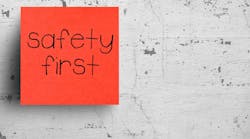I took a tumble walking to my car after work the other day. It was my fault entirely. I chose to step over a rope fence rather than walk the extra 200 feet to the proper opening of the parking lot.
I wasn’t hurt despite my foolish decision to take a shortcut for the sake of expediency over safety, but I could have been.
Ironically, my escapade occurred shortly after I read OSHA’s top 10 most frequently cited workplace safety violations for fiscal year 2019. They were released in September at the National Safety Council 2019 Congress and Expo. It’s a preliminary list, but I suspect the final ranking won’t vary much.
If you haven’t seen the ranking, here it is:
1. Fall Protection – general requirements
2. Hazard Communication
3. Scaffolding
4. Lockout/Tagout
5. Respiratory Protection
6. Ladders
7. Powered industrial trucks
8. Fall protection – training requirements
9. Machine guarding
10. Eye and face protection
These top 10 offenses contributed a total of 26,915 violations during the 2019 fiscal year. This list isn’t specific to manufacturing, but I have no doubt manufacturing contributed a healthy percentage to these statistics.
For all that we talk about manufacturing no longer being “dark, dangerous and dirty,” the truth is that it can still be dangerous. In recent examples, OSHA closed out the month of September by citing a Mississippi manufacturing facility for exposing employees to struck-by and fall hazards following a fatality at the site. Three days earlier, OSHA cited a Georgia manufacturing site for similar violations where, like in Mississippi, a person died in the incident.
Neither of these examples take into account the numbers of OSHA citations issued absent a fatality or absent an injury, but of course there are plenty of those as well. In 2017, the last year for which the U.S. Bureau of Labor Statistics has released final data, manufacturing ranked second in the number of non-fatal occupational injuries and illnesses by private industry, and fifth in incidence rates.
Yes, manufacturing can be dangerous. People work with big pieces of equipment, manufacturing processes can and do involve extreme heat and extreme weight, and too many repetitious motions can cause the human body to revolt.
Some of those dangers we can’t eliminate, at least not now or at least not completely—making steel will always require heat, stamping metal will always require pressure. What we can do, however, is mitigate the danger. We can create an environment that supports the best possible outcome in terms of safety, not the worst. OSHA standards are an ingredient to making that happen.
Plenty of manufacturers are doing things right and continue to evolve their approaches to safety. Earlier this year, for example, IndustryWeek wrote about Toyota’s embrace of exoskeletons as mandatory personal protective equipment for overhead work at several of its facilities. And every single IndustryWeek Best Plants Award winner we’ve honored has had a robust safety program that routinely delivers OSHA incidence rates that are a fraction of their industry average.
A lot of exciting things are happening in manufacturing—business is good for many U.S. manufacturers, new technologies seemingly are rolling out every day, and if the manufacturing community is successful, more young people will be joining in the business of making things.
Just let’s not forget the basics as we move forward. And keeping your people safe is the basics. The most important basic.





